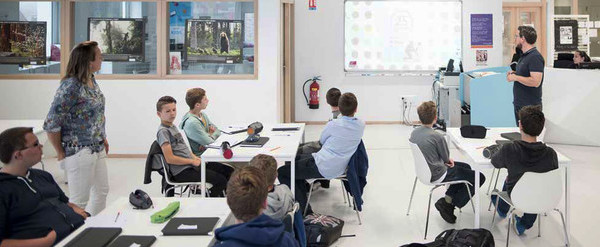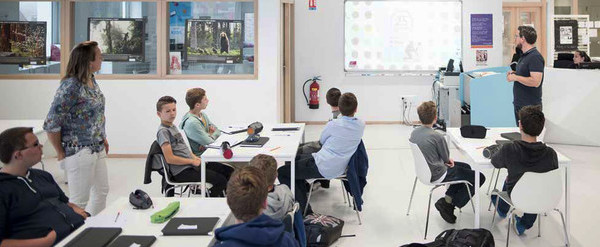The reform of the baccalauréat has introduced a new speciality course in 2019: "Numérique et Sciences Informatiques" (NSI).
The NSI specialization (four hours per week in première and six hours in terminale) has succeeded the previous Computer Science and Digital Science specialization (two hours per week) introduced in 2012, which was only offered to terminale S students.
Today, this teaching is provided by teachers holding the CAPES NSI or the inter-university diploma "Enseigner l'informatique au lycée" ("Teaching computer science in high schools") to be introduced in 2019.
Five years on, where do we stand?
Only 10% of students opted for the NSI speciality in première and 4.3% in terminale.
At the start of the 2023 school year, 38,091 first-year students chose the "digital and computer sciences" course, representing 10.1% of all students (compared with 34,721 in 2020, representing 9%). NSI ranks 8th among the most popular courses chosen in Première.
At the start of the 2023 school year, 17,612 students were pursuing the NSI specialty in their final year, representing 4.3% of all students (13,884 in 2020, 3.7%).
Référence :
More than half of Première students who took the NSI specialization dropped out in Terminale
In terminale, students have to give up one of the three speciality courses taken in première. With a 53% dropout rate, NSI is one of the most abandoned specialties, along with Latin-Greek and Engineering Sciences. A higher proportion of girls drop out of NSI in their final year.
Four times as many boys as girls in Première, 7 times as many in Terminale
Only 19.3% of students taking the NSI specialization in première are girls: their share drops to 15.2% in terminale. However, there is a slight downward trend, with the proportion of girls choosing NSI rising in première from 4.5% in 2020 to 4.2% in 2023. And in the final year, from 6.7% to 5.6%.
Girls account for 56% of students in Terminale Générale. They are over-represented in the arts, Latin and Greek (79%), humanities, literature and philosophy-HLP (82%) and languages (73%). Conversely, they are under-represented in Engineering Sciences (14%), NSI (15%), Physical Education (32%) and, to a lesser extent, "Mathematics" (42%) and "Physics-Chemistry" (46%).
The choice of NSI is largely determined by social background: among students who chose it in their final year, 41% were from a very privileged social background, 14% from a privileged social background, 23% from an average social background and 21% from a disadvantaged social background.
A target of doubling the number of girls by 2027
In its Avis sur la contribution du numérique à la transmission des savoirs et à l'amélioration des pratiques pédagogiques (Opinion on the contribution of digital technology to the transmission of knowledge and the improvement of teaching practices), the Conseil supérieur des programmes (CSP) recommended "promoting, particularly among young girls, the various aspects of computer science education , which is not limited to training future code developers and opens up varied and promising prospects for further study, particularly in data science and artificial intelligence".
The CSP attributed girls' disaffection with computer science studies since the 1980s "to the weight of popular culture:
- on the one hand, when children began to buy personal computers, boys were favored over girls for a long time;
- on the other hand, the culture of a certain kind of computer use has helped to associate computing with the male world among the general public;
- finally, the image of the computer scientist, born of this association, is that of an asocial individual spending his time typing lines of code on a computer keyboard. More recently, the free software movement, with its predominantly male communities, has reinforced this bias by constructing the figure of the "snooper" (hacker) as a model of the developer".
The Ministry's Digital Strategy for Education 2023-2027, adopted in 2023, proposes to "consolidate the momentum of the Numérique et sciences informatiques (NSI) specialization, particularly among young girls.
- the proportion of high schools offering the NSI specialty in situ will rise from 62% today to 75% by 2027;
- Specific initiatives to promote science, particularly digital science, will be carried out for high school girls in conjunction with research and higher education establishments;
- parity targets will be set for each academy, with a view to achieving parity in the NSI, with a minimum doubling of the proportion of girls by 2023".
Références :
For Société Informatique de France, " there ' s a real danger here ".
The trajectory of this teaching, the absence of NSI in a third of high schools and the low number of CAPES NSI and agrégation posts are of concern to the Société informatique de France.
"NSI's enrolments are insufficient - worse, they're stagnating. As early as 2020, we were alarmed by the low number of students choosing computer science. The revelation of the 2023 figures is worrying: enrolments are falling. Not only is this still far too low given the need for jobs in IT, and the need for IT literacy among future citizens, but NSI is also stagnating.
While girls represent 55.6% of students, the rate of girls in NSI will be 15.2% in 2023. Do we really need to point out how despairing this statistic is? The increase on last year is 0.6 points. At this rate, the Ministry's target of 30% girls will be reached around... 2050. (...) After four years of existence, the NSI specialization has plateaued, to the point of falling to a very low level in the final year. At the lycée général, the situation is distressing (...)
And yet, there are countless computer awareness programs, particularly aimed at women. Whether local or national, they remain ineffective, given the figures for NSI. Nor does orientation assistance seem to be any more effective. On the other hand, the change in the structure of the high school has led to drastic and sudden changes: a drop in the number of science students, particularly girls, a drop in the number and rate of girls in computer science, an increase in the differences between socio-professional categories, and persistent inequalities between regions".
Référence :








